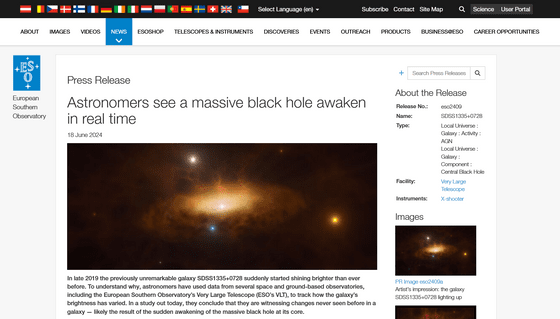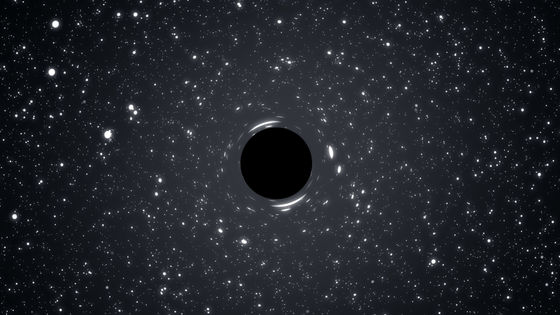Astronomers observe for the first time the sudden 'awakening' of a supermassive black hole at the center of a galaxy

An astronomy team led by the European Southern Observatory (ESO) announced that a dormant black hole at the center of a galaxy suddenly became active, causing the galaxy to emit a brighter light than ever before. This may be the first recorded case of the formation of an '
SDSS1335+0728: The awakening of a ~10^6 M_sun black hole | Astronomy & Astrophysics (A&A)
https://www.aanda.org/component/article?access=doi&doi=10.1051/0004-6361/202347957
Astronomers see a massive black hole awaken in real time | ESO
https://www.eso.org/public/news/eso2409/

Astronomers watch a supermassive black hole turn on for the first time
A black hole is a celestial body with such gravity that even light cannot escape it, but when it actively engulfs surrounding matter, it emits strong light and X-rays from the accretion disk and high-temperature gas that form. Conversely, when there is no more matter to engulf from the surroundings, the black hole stops growing, and such a black hole is called a 'dormant black hole.'
Located 300 million light years from Earth, the galaxy SDSS1335+0728 is believed to harbor a supermassive black hole with a mass 1.5 million times that of the Sun at its center, but has not shown any signs of activity for over 20 years.

However, in December 2019, astronomers noticed that SDSS1335+0728 had suddenly begun to shine brighter. Similar light can also be observed in supernova explosions , when a massive star reaches the end of its life and explodes, or intidal collapse , when an object gets too close to a supermassive black hole and collapses, but these events generally last only a few days, or at most a few months.
SDSS1335+0728 has been actively emitting visible light, ultraviolet light, and infrared light for over four years, and has also begun emitting X-rays since February 2024.
'The most concrete explanation for this phenomenon is that we are witnessing the core of a galaxy becoming active,' said Lorena Hernández-García, an astronomer at the Millennium Institute for Astrophysics in Chile. 'If this is the case, it would be the first time we've seen a supermassive black hole become active in real time.'
In the 15-second video below released by ESO, you can see a visual of the process by which SDSS1335+0728 begins to shine actively.
Artist's animation of the black hole at the centre of SDSS1335+0728 awakening in real time - YouTube
So far, it's still unclear what's happening at the heart of SDSS1335+0728, so astronomers are pinning their hopes on future observations by spacecraft such as NASA's James Webb Space Telescope.
'All the data we have seems to indicate that we are observing the formation of an AGN for the first time. We hope that from this source of radiation we will be able to learn how AGNs become AGNs and how supermassive black holes grow,' said ESO's Paula Sáez.
Related Posts:
in Science, Posted by log1l_ks







